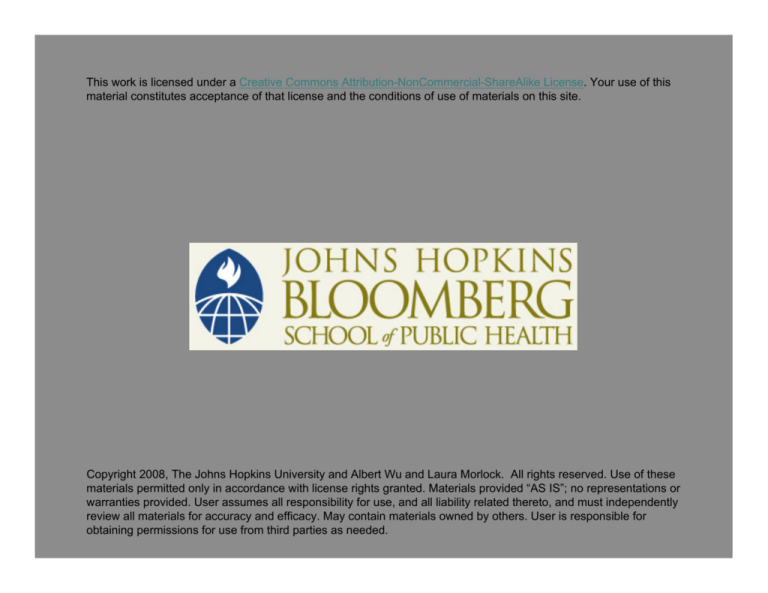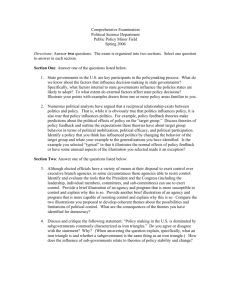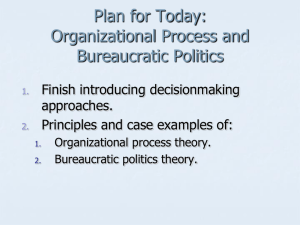
This work is licensed under a Creative Commons Attribution-NonCommercial-ShareAlike License. Your use of this
material constitutes acceptance of that license and the conditions of use of materials on this site.
Copyright 2008, The Johns Hopkins University and Albert Wu and Laura Morlock. All rights reserved. Use of these
materials permitted only in accordance with license rights granted. Materials provided “AS IS”; no representations or
warranties provided. User assumes all responsibility for use, and all liability related thereto, and must independently
review all materials for accuracy and efficacy. May contain materials owned by others. User is responsible for
obtaining permissions for use from third parties as needed.
Systems of Influence
Laura Morlock, PhD, MA
Albert W. Wu, MD, MPH
Johns Hopkins University
Section A
Systems of Influence in Organizations
Systems of Influence in Organizations*
Four systems of influence operate simultaneously in
organizations to affect our behavior:
1. The system of formal authority
2. The system of expertise
3. Organizational politics
4. Organizational culture
*Mintzberg, Henri. (1983). Power in and around organizations.
Englewood Cliffs, New Jersey: Prentice-Hall.
4
System of Authority
Formal control structure of the organization
Coordination of activities is achieved through a formal
hierarchy of positions
Individuals participate as superiors and subordinates
Influence is exerted through both personal and bureaucratic
controls
5
System of Authority: Personal Controls
Personal controls
− Giving direct orders
− Setting decision premises/boundaries
− Reviewing decisions of subordinates
− Allocating resources
6
System of Authority: Bureaucratic Controls
Bureaucratic controls
− Establishment of impersonal standards that guide
decisions and activities
X May be for the content of work performed (e.g.,
formalizing job descriptions, rules and regulations,
standardizing work procedures)
X May be set with respect to the goals to be achieved
7
System of Authority: Rewards and Sanctions
At least in theory, controls are reinforced by the
organization’s formal system of rewards and sanctions
8
System of Expertise
Develops in organizations where work to be performed is
complex enough that key participants must include technical
experts or professionals who have received considerable
training outside the work setting
At least in theory, work standards are internalized through a
long period of training
9
System of Expertise
Develops in organizations where work to be performed is
complex enough that key participants must include technical
experts or professionals who have received considerable
training outside the work setting
At least in theory, work standards are internalized through a
long period of training
Coordination is achieved through standardization of skills,
interpersonal consultation, and mutual adjustment
Often results in “status hierarchies” based on complexity of
the skills and the degree to which they are critical to the
organization
10
Organizational Culture
System of shared beliefs about the organization that make it
unique or at least distinctive to its members
Individuals participate as “members”
A strong culture has a unifying and “leveling” effect on
individuals who participate as members
11
Organizational Politics
Arena in which participants try to exert influence over
decisions and activities in ways that are informal and
illegitimate in the sense that they are not sanctioned by
formal authority, certified expertise, or the organizational
culture
Arises when there are gaps in the other influence systems
12
Organizational Politics
Arena in which participants try to exert influence over
decisions and activities in ways that are informal and
illegitimate in the sense that they are not sanctioned by
formal authority, certified expertise, or the organizational
culture
Arises when there are gaps in the other influence systems
Influence is exerted through one or more “games,” each with
its own structure and rules
Individuals participate as players and observers
13
Section B
Organizational Politics
Organizational Politics—Summary
Arena in which participants try to exert influence over
decisions and activities in ways that are informal and
illegitimate in the sense that they are not sanctioned by
formal authority, certified expertise, or the organizational
culture
Arises when there are gaps in the other influence systems
Influence is exerted through one or more “games,” each with
its own structure and rules (not everybody plays)
Individuals participate as players and observers
Most visible games are various kinds of budgeting games
Political games also arise because of patient safety
15
The Patient Safety Games: Blame
The “blame game”
Photo: Judith Schonbach.
16
The Patient Safety Games: Reporting System
Reporting system games
− “Not on my watch”
− “Not on my turf”
−
DVT example—errors of omission
17
The Patient Safety Games: Performance Data
Games surrounding performance data
− Shoot the messenger
− Criticize the methods
− Change the case mix
− Filter the data
−
−
−
Examples: CABG mortality
Drive out fear, or fear will drive the data
Filter: Exclude from denominator
18
Games Involving the Reporting of Performance Data
Fear
Micromanage
Kill the messenger
(denial; shift the blame)
Filter the data
(game the system)
Source: Scherkenback. (1991).
19
The Patient Safety Games: Performance Data
Games surrounding performance data
− Shoot the messenger
− Criticize the methods
− Change the case mix
− Filter the data
−
−
−
Examples: CABG mortality
Drive out fear, or fear will drive the data
Filter: Exclude from denominator
20
Lessons for Patient Safety
These four systems of influence operate simultaneously in all
organizations, including health care settings
Leaders with authority and leaders with expertise (physicians,
nurses, pharmacists, and others) need to be visibly committed
to patient safety goals
− One good example: Executive “walk-arounds”
− Another: Involving clinical experts who are “thought
leaders” in the development of guidelines
21
Lessons for Patient Safety (cont.)
We need to be aware that “bad news,” such as the experience
of adverse events, does not travel easily up hierarchies of
authority or status
22
Lessons for Patient Safety (cont.)
Strengthening the system of culture has an equalizing effect
on the members of an organization, makes it easier to focus
on the patient’s safety, and facilitates adverse event reporting
Strengthening the roles of formal authority, expertise, and
culture in efforts to improve patient safety will weaken the
system of politics and gamesmanship
23










